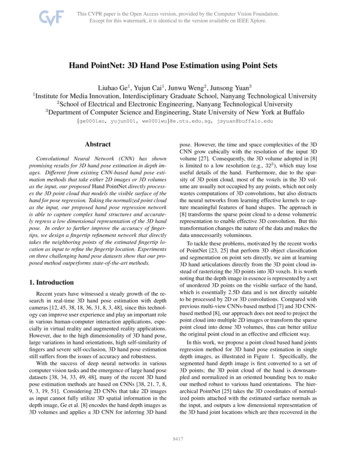
Transcription
The Hand-Loom Weaver and the Power Loom:A Schumpeterian PerspectiveRobert C. AllenWorking Paper # 0004May 2017Division of Social Science Working Paper SeriesNew York University Abu Dhabi, Saadiyat Island P.O Box 129188, Abu Dhabi, cial-science.html
The Hand-Loom Weaver and the Power Loom:A Schumpeterian Perspective REVISEDbyRobert C. AllenGlobal Distinguished Professor of Economic HistoryFaculty of Social ScienceNew York University Abu DhabiP.O. Box 129188Abu DhabiUnited Arab EmiratesSenior Research FellowOxford UniversityNuffield CollegeNew RoadOxford OX1 1NHUnited Kingdombob.allen@nyu.eduThe empirics of this paper rest on John Lyon’s Ph.D. dissertation The Lancashire CottonIndustry and the Introduction of this Powerloom, 1815-1850. This is an impressively wellinformed and thorough reconstruction of the technology and economics of the industry. Thispaper could not have been written without it. John Lyons sadly died in 2011. I dedicate thepaper to him.This is a revised version of a discussion paper originally issued asOxford University, Working Papers in Economic and Social History, Number 142, 20162017
AbstractRobert C. AllenThe Hand Loom Weaver and the Power Loom: A Schumpeterian Perspective,Schumpeter’s ‘perennial gale of creative destruction’ blew strongly through Britain duringthe Industrial Revolution, as the factory mode of production displaced the cottage mode inmany industries. A famous example is the shift from hand loom weaving to the use of powerlooms in mills. As the use of power looms expanded, the price of cloth fell, and the ‘goldenage of the hand loom weaver’ gave way to poverty and unemployment. This paper arguesthat the fates of the hand and machine processes were even more closely interwoven. Withthe expansion of factory spinning in the 1780s, the demand for hand loom weavers soared inorder to process the newly available cheap yarn. The rise in demand raised the earnings ofhand loom weavers, thereby, creating the ‘golden age’. The high earnings also increased theprofitability of developing the power loom by raising the value of the labour that it saved.This meant that less efficient–hence, cheaper to develop--power looms could be brought intocommercial use than would have been the case had the golden age not occurred. Thecounterfactual possibilities are explored with a model of the costs of weaving by hand and bypower. The cottage mode of production was an efficient system of producing cloth, but itself-destructed as its expansion after 1780 raised the demand for sector-specific skills, thusproviding the incentive for inventors to develop a power technology to replace it. The powerloom, in turn, devalued the old skills, so poverty accompanied progress.JEL codes: N63, N34, O31keywords: technological change, invention, technological unemployment, creativedestruction
Schumpter (1994, pp. 84, 87, 88) maintained that capitalism progressed through ‘aperennial gale of creative destruction’ in which new modes of production with higherproductivity replaced older modes with lower productivity. In the course of advance,outmoded machinery was junked, and workers with old fashioned skills lost their livelihoodsas they too landed on the scrap heap of history. The genius of capitalism resides as much inthe destruction of the old as in the creation of the new.At the industry level, we can see the individual gusts that made up Schumpeter’s gale.The Industrial Revolution consisted of one blast after another. In textile production, whereone stage (spinning) fed into another (weaving), a technological breakthrough in one createdan inbalance that led to a technological breakthrough in the next. The result was waves ofcreative destruction.The first bottleneck occurred in spinning. The spinning of wool, flax, and later cottonwas carried out by women working in cottages across England. Earnings were similar acrossall the sectors since women shifted between them, and all were eventually mechanized. Asthe wool industry expanded in the seventeenth century due to an abundance of long hairedsheep and growing demand from Britain’s expanding mercantile empire, the employment ofwomen rose. By the end of the seventeenth century, the labour market was tight, and theirwage jumped up. The rise in their wage meant that Hargreaves’ spinning jenny andArkwright’s water frame, which would not have been profitable to use in the conditions ofthe seventeenth century, suddenly became profitable. As a result, Hargreaves and Arkwrightexpended the resources to develop them. By the 1770s, commercially viable designs weredeveloped, and the factory production of textiles took off. The cottage mode of productionwas destroyed as women stopped spinning in their cottages, and their wheels were tossed inthe barn. The ‘contradiction’ that led to the destruction of the cottage mode of production atits zenith was the shortage of skilled spinners (rather than the immiseration of the workforcethat Marx (1867, Part 8, chapter 30) supposed). Their high wages led inventors to develop areplacement technology that overturned the cottage mode and created the factory mode(Allen 2015, 2017).This paper is about the next gust of creative destruction–the invention of powerweaving and the demise of the hand loom weaver. The course of events was similar. Theinvention of machine spinning led to a huge supply of cheap yarn. This led to inbalancebetween the sectors. The demand for weavers shot up from about 37 thousand in 1780 to95,000 in 1792 to a peak of 240,000 in 1820 (Table 1). As employment expanded in the lateeighteenth century, the earnings of weavers were also bid up producing a Golden Age duringthe Napoleon Wars (Bythell 1969). It was the high wages earned by hand loom weavers inthat period that led to the development of the power loom, for the high wages meant that lessadvanced versions of the power loom could be used commercially than would have been thecase had wages remained at their earlier, lower levels. Less R&D expenditure was necessaryto make the transition from experimental designs to operational prototypes than would havebeen necessary earlier or would have been the case in other economies where wages werelower. This was the ‘contradiction’ through which the expansion of the cottage mode ofproduction led to its own demise, as the factory replaced it. Once again the cottage mode ofproduction was destroyed at its zenith not by the immiseration of the work force but by itsprosperity. Immiseration quickly followed, however, for wages collapsed in the 1820s andemployment levels followed in the 1830s and 1840s. Between about 1815 and 1845, theshare of cotton cloth woven by power increased from 5% to 95% (Table 1). The weavers lostthe high rent jobs they had enjoyed, and hand looms eventually became play things for theartsy-craftsy middle class.These stories of technical change in the cotton industry bear on general explanations
2of the Industrial Revolution since they emphasize the importance of demand factors drivingeconomic progress. Many widely accepted views emphasize factors affecting the supply oftechnology. Clark (2007) has offered a cultural explanation for the Industrial Revolution (inthe aftermath of the black death, a ‘genetic process’ produced a British population that wasbetter behaved and more responsive to economic incentives than people elsewhere), as hasMokyr (2002) (in the aftermath of the scientific revolution, communications networks sprangup in Britain in which natural philosophers offered businessmen tips on how to respond morescientifically to economic opportunities).1 On the other hand, North and Weingast (1989)and Acemoglu and Robinson (2012) have offered a political explanation (the GloriousRevolution replaced arbitrary royal government with the rule of law and security of propertywith the result that businessmen responded to economic incentives rather than beingdistracted by rent seeking). What these theories have in common is a focus on theresponsiveness of economic actors to incentives in the market. The cultural or politicalchange led businessmen and inventors to become more rational, savvy, confident, or focussedand consequently to respond better to their opportunities. The limitation of all of thesetheories is that they leave those opportunities unexamined.2 Did inventors in late eighteenthcentury England face the same opportunities as their ancestors or their counterparts in othercountries? Was the Industrial Revolution the result of an unusual responsiveness toincentives or was it the result of unusual incentives? The Schumpeterian perspectiveexplored here emphasizes how the evolution of markets created the incentives that inventorsfaced and can explain the timing of their efforts more precisely than other approaches.3The theory of induced innovationMy analysis of the power loom is an application of the theory of induced innovation.This theory of technological change was originated by Sir John Hicks’ Theory of Wages(1932, p. 124) when he suggested that "a change in the relative prices of the factors ofproduction is itself a spur to invention, and to invention of a particular kind—directed toeconomizing the use of a factor which has become relatively expensive." Hick’s claim waslittle more than a conjecture, and economists have been elaborating it since. Theoreticalpapers in the 1960s (Kennedy 1964, Samuelson 1965) produced models capturing some1O’Brien (1997) examined the life and writings of Edmund Cartwright, the inventorof the power loom, in detail to investigate Mokyr’s view and found no evidence in support ofit.2Studies of specific technologies of the industrial revolution have paid more attentionto the incentives created by the profitability of old and new techniques than the more generaltreatments mentioned here. See, for instance, Hyde (1977), von Tunzelmann (1978),Nuvolari and Verspagen (2009), and Allen (2009). These studies were following a traditionthat assessed Victorian entrepreneurship in profitability terms (McCloskey 1973, Sandberg1974).3Despite my Schumpeterian approach, this paper is influenced by Harley (1971,1973).
3features of Hick’s insight but with peculiar assumptions about firm behaviour like themaximization productivity growth rather than profit (Acemoglu 2003). Empirical research,primarily concerning agriculture and energy, however, found support for the inducedinnovation framework (Hayam and Ruttan 1971, Newell, Jaffe, and Stavins 1999, Popp 2002,Aghion et al 2016).The development of endogenous growth theory provided a richer environment tomodel induced innovation in a more plausible way. An important first step was Acemoglu’s(2002b) research on ‘directed technical change.” The model was developed to explain whythe stock of educated workers and their earnings were both rising in the United States in thelate twentieth century. Acemoglu posited a production function in which output depended onboth educated and uneducated labour. The productivity of each could be augmented by newmachines, which, in turn, were supplied by monopolistic suppliers. They allocated resourcesbetween the two types of labour in response to profit opportunities, which depended onrelative wages–a nod to Hick’s 1932 proposal–and potential market size. A greater supply ofa factor, educated labour for instance, could cause an increase in the demand for that factorthat exceeded the increase in supply. When that happened, the wage of educated labourcould rise even as its supply was rising. This unexpected result diluted the support the modelgave to Hick’s view.The ‘directed technical change’ model has been applied to economic history.Acemoglu (2002a, p. 12, 42-3) believed it captured the essence of Habakkuk’s (1962) workon labour scarcity and American technology in the nineteenth century as well as the inventionof the cotton mill in Britain during the Industrial Revolution. Hanlon (2015) is a compellingapplication of the model to invention during the cotton famine of the early 1860s.In 2010, Acemoglu re-engaged with the issue of labour scarcity and developedconditions under which it would–or would not–influence the direction of technical change ina theoretical model. This was an important step in moving beyond factor augmentingrepresentations of technical change, which preclude this possibility.Acemoglu and Restrepo (2017) propose a new and more compelling model of inducedinnovation that builds on Acemoglu (2010) and gives clearer expression to Hick’s intuition.This model is prompted by concerns about the impact of automation on wages and thedistribution of income with obvious parallels to the handloom weaver and the power loom.In the new model, GDP is determined by the productivity of labour in tasks. Tasks can beaccomplished by labour alone or in conjunction with machines. Technical change involveseither the mechanization of existing tasks (robots building automobiles) or the creation ofnew complex tasks that are performed by people alone (personal assistants). Monopolisticsuppliers of technology can create either new machines or new complex tasks, and the choicedepends on the relative profitability of the two options. “The task-basedframework–differently from the standard models of directed technological change which arebased on factor-augmenting technologies–implies that as a factor becomes cheaper, this notonly influences the range of tasks allocated to it, but also generates incentives for theintroduction of technologies that allow firms to utilize this factor more intensively.”(Acemoglu and Restrepo 2917, p. 36) Conversely, when a factor–e.g. labour–becomes moreexpensive, technology is developed to economize on its use as Hicks suggested.In the Acemoglu-Restrepo model, the immediate impact of automation is alwaysdetrimental to workers. “Automation always reduces the labor share and employment, andmay even reduce wages.” (p. 3) This is an alternative explanation to the wage stagnation inBritain in the first half of the nineteenth century (Allen 2009). However, an importantfeature of the Acemoglu-Restrepo model is that a capitalist economy includes ‘self-
4correction’ features to prevent automation from rendering everyone unemployed: Asautomation proceeds, wages fall, and this increases the incentive for firms to shift resourcestowards inventing more complex tasks. Under many circumstances, the expansion ofemployment in those sectors stabilizes employment and earnings. Presumably the expansionof new high productivity jobs later in the nineteenth century was the immediate cause of therise in real wages that began around the 1840s (Allen 2009, 2017).A full scale application of the Acemoglu-Restrepo model to the industrial revolutionwould include an analysis of the creation of new, complex tasks manifest in the vastexpansion of middle class jobs during the period (Allen 2017, pp 60-71). The focus of thispaper, however, is narrower and concentrates on one of the dramatic episodes ofmechanization–the invention and diffusion of the power loom. In Acemoglu-Restrepo terms,the ‘task’ that was transformed was weaving cotton yarn into cloth. Workers could do it byhand with virtually no capital or with power looms, which were very capital intensive for theperiod. The invention of the spinning mill, which flooded the market with cheap yarn in the1780s, was a shock which raised the weaver’s wage above its balanced growth path.Inventors responded by directing resources to perfecting the power loom. Its introductioninto commercial use caused a sharp decline in the employment and wages of handloomweavers, as predicted by the model.the handloom sectorThe first step in developing this view of the economy is describing the technologies ofthe period. The handloom was the traditional device for weaving cloth. While it wasthousands of years old, the system of business organization was comparatively modern.Looms were ordinarily located in the cottages where the weavers lived, and, for that reason, Irefer to this system of business organization as the cottage mode of production. The weaverswere employed as contract employees by manufacturers, who supplied them with yarn,collected the finished cloth, and paid the weavers by the piece.To understand the invention of the power-loom and the competition between it andthe handloom, it is necessary to know the evolution of weavers’ incomes. There are manycontemporary estimates of weekly earnings. In reality, there was a range of incomereflecting differences in skill and effort. To deal with that situation, Wood (1910, pp. 425-33,593-6), Bowley 1902, pp. 106-8, 112-4) and Palgrave (1926, pp. 634-5), who collected thisinformation, usually recorded the income of either a ‘good’ or an ‘ordinary’ worker.Feinstein (1998, p. 189) combined some early figures with Wood’s index for the latter part ofthe period to form the series in Figure 1. In 1770, earnings were not particularly high, butthey grew rapidly in the next twenty years as the factory production of cotton yarn explodedand along with it the demand for weavers. The years from 1793 to 1817 were the “halcyondays” in which “the hand-loom weaver was in the enviable position of a man who hadsomething valuable to sell and could make very comfortable terms for himself.” (Hammondand Hammond 1919, p. 18) After Waterloo, the hand loom weaver’s fortunes reversed, andtheir circumstances became grim, indeed.As well as organizing production, the manufacturer inventoried raw materials andfinished cloth. He also prepared the beam, that is the shaft around which was wound thethousands of lengths of yarn that comprised the warp of the cloth. These beams were thenmounted on the looms and were crisscrossed with weft as each piece of cloth was woven.The profit earned by the manufacturer for a piece of cloth equalled the price of the pieceminus the cost of the yarn, the payments to the weaver, and the other costs of doing business.
5Hence, a second way to calculate the weaver’s income is to subtract yarn and manufacturers’costs from the sale price of the cloth.income/wk (price - yarn cost - manufacturers’ costs and income) * pieces per week(1)This method corroborates the contemporary estimates, as will be shown for two specifictypes of cloth.There was a great variety of cloths, that differed in terms of the fineness of the yarnand the character of the weave. I concentrate on what has come to be called Neild printer’scloth4 since it was an industry standard that was widely produced and has been welldocumented. The precise specification of the cloth is important to work out its cost and theearnings of weavers. A piece of Neild cloth was 29 yards long and 28 inches wide. It waswoven with 36 count yarn with a weave of 84 threads per inch of weft and 77 threads perinch of warp. Each piece contained 2.215 pounds of warp and 2.415 pounds of weft (Lyons1977, p. 195).How much of this cloth could be woven in a week? The answer depended on howmany hours the weaver worked and how much was produced each hour. There was aconsiderable range in productivity, so I concentrate on a ‘good’ male working full time.Following Voth’s (2000, pp. 118-33) analysis of the working day, I assume that weaversworked five days per week (they rested on Sunday and celebrated Saint Monday) and 11hours per day. One and a half of those work hours were, however, devoted to eating, soactual work hours were 9.5 per day or 47.5 per week. A work day of 9 hours is taken as thestandard in the Indian Report of the Fact-Finding Committee (Handloom and Mills) (1942,pp. 57-9), which provides some corroboration. In addition, these studies show that onlyabout 65% of the weaver’s work time was actually spent moving the shuttle across the loom(‘uptime’). The other 35% was taken up with set-up tasks and repairing broken threads(‘downtime’)5.How much cloth was produced depended on how many times per minute the shuttlemoved across the loom when weaving was actually under way. Each traverse of the shuttleconstituted a pick, and the pick rate of a good weaver was said to be 100 shots per minuteduring the Industrial Revolution.6 Confirmation of this figure comes from Egyptian andmodern Indian sources that report similar values. (Latif 1997, p. 197, Clark 1908, p. 51).Allowing for 35% ‘downtime,’ the good weaver achieved a speed of 65 picks per minuteaveraged over the working day. (In this paper the speed of a loom will mean the averagespeed over the day, which equals the speed while in operation multiplied by the fraction ofthe day the loom operates, its ‘uptime’.) Given that printer’s cloth contained 84 threads perinch of weft, a weaver produced 61.26 yards per day. In a year a weaver produced 3062.5yards or 105.6 pieces of 29 yards each.While printer’s cloth is the focus of this study, I also analyse a coarser cloth that was4A price series for this specification of cloth was originally published by Neild(1861).56Latif (1997, p. 197).This rate is achieved on cloth one yard wide. On broadcloth, the rate dropped to 80.White (1846, pp. 32-3).
6more typical of production in the early stages of the cotton industry to estimate weaver’searnings. The paradigm is Cardwell’s ‘fine’ calico, whose price was reported by Harley(1998, p. 79) for the period 1779-98. It was made from 20 count warp and 18 count weft7.We do not have a description of the cloth reporting the number of warp and weft threads perinch, but these can be worked out from the norms for Indian hand woven cloth in the 1950s.8Again assuming that the weaver makes 100 picks per minute during his ‘up time,’ he wove3.66 pieces per week of 28 yards each, and each piece required 3.598 lbs of warp and 3.68 lbsof weft.With these analyses of the productivity of a handloom weaver, we can calculate theincome per day of the weaver from the prices of cloth, yarn, and manufacturers’ costs.Figure 2 shows the implied incomes of ‘good’ male weavers from 1770 through 18399. Thefigure also shows the daily income of a building labourer. In 1768 when Arthur Youngvisited Manchester, a weaver earned about 70% of a building labourer’s wage. Around 1780,at the start of the great cotton boom, hand loom weavers had high earnings making coarsecloth, but by the late 1780s and for the early 1790s, their earnings (while variable) were likethose of labourers.From the late 1790s, the earnings of handloom weavers surged, and they earned muchmore than labourers for the next 20 years (although their earnings dropped briefly after theresumption of war in 1803). The premium was the ‘rent’ that the handloom weaver earned as7Harley (1998, P. 79) states that the cloth was made with 18 count yarn. Harleyreports a price for 18 count weft but 20 count warp, and so I base costs on that description.8Amalsad (1961) not only explains the methodology but provides a worked exampleon pp. 20-22 that can be readily adapted to Cardwell’s fine calico. Amalsad’s example is fora piece of Grey Long Cloth 36 inches wide and 40 yards long with a warp of 20 count and aweft of 18 and a 54 x50 weave.9The data to calculate income are taken from the following sources:price–price of a piece of printer’s cloth for 1812-60 as reported by Neild (1861), standardizedfor size by Lyons (1977, p. 195), and extended back to 1781 by Harley (1998, pp. 80-2). ForCarldwell’s fine calico, I use Harley (1998, p. 79).yarn prices–for Neild cloth, see Appendix. For Caldwell’s fine calico, 18 count weft wastaken from Harley (1998, p. 74) and 20 count warp from Harley (1998, p. 75) with someinterpolations based on the price of 18 count weft.manufacturer’s current costs–from Lyons (1977, pp. 244-7).manufacturer’s fixed capital costs–Lyons (1977, pp. 250-1)manufacturer’s working capital costs–Lyons (1977, pp. 251-2). The value of inventory was afunction of its price, and it was necessary to solve this out in computing the supply price ofhandloom cloth when the weaver’s wage was changed to the building labourer’s wage.manufacturer’s income–set to 130 per year in 1815 on a production rate of 22500 pieces peryear (Lyons 1977, p. 211n20). This output equalled the capacity of the warping machine andcorresponded roughly to that of Lyon’s model power mill at the same date. Entrepreneurialincome was kept constant in later years in view of the roughly constant nominal wage level inmanufacturing. Incomes before 1810 were reduced in accord with the wage of a buildinglabourer in Lancashire.
7a return to his now scarce skill. On average from 1793 to 1817, rent increased the handloomweaver’s earnings by 93% compared to what their earnings would have been had the patternof the 1770s continued to prevail.10 This period was the famous ‘golden age of the handloomweaver.’ It was important in the social history of the period, and it was important for itstechnological history, as we shall see.The invention of the power loomThe Rev. Edmund Cartwright11 is credited with inventing the power loom, althoughhe never succeeded in making a commercially viable model. In 1784 while in Matlock onholiday, he dined with ‘some gentlemen from Manchester’ and proposed that weaving bemechanized as spinning had been. Cartwright’s suggestion was inspired by Frenchautomatons–the mechanized figures that moved in lifelike ways.12 If a mechanical womancould play a dulcimer, couldn’t she also weave calico? Despite knowing little of machinery,Cartwright made a mechanical loom after his holiday. The device was cumbersome andrequired two men to operate; nonetheless, he received a patent for it.Cartwright’s loom was not commercially viable and illustrates the fundamentalcharacter of eighteenth century invention. Invention was not primarily about novel ideas;instead, it consisted of the practical engineering that converted often banal ideas into reliablemachines that were cost effective in production. As Thomas Edison quipped, ‘invention isone per cent inspiration and ninety-nine percent perspiration.” Since invention meant R&D,it required the expenditure of money and resources, and so it responded to economicincentives.Cartwright expended a fortune trying to perfect his loom. He employed skilledmechanics to do the work and received patents on improved designs in 1786, 1787, and 1790.In the late 1780s, he built a 20 loom mill, powered first by a bull and then by a steam engine.In 1790, a 400 loom mill was built by leasees, but it was burnt down. That was the end ofCartwright’s experiments. He had invested about 30,000 in the power loom.Other inventors also worked on the problem in the 1790s. (Cartwright complainedabout infringements of his patents and was awarded 10,000 in compensation by Parliamentin 1809.) The key breakthrough was made by William Horrocks in Stockport. He startedworking with power looms in 1795 and had about 50 in operation in 1800. In 1802 hereceived a patent for his major invention which was the use of a crank to drive the parts ofthe loom rather than cams as in the earlier designs of Miller and Austin. Horrocks’ loom wasthe first to make the transition from R&D to commercial use (Timmins 1996, p. 46, Lyons1977, p. 69, 115, 116 n. 6).Productivity growth in power weaving10In 1793-1817, the earnings of the handloom weaver were 93% greater than theircounterfactual earnings equal to 70% of a building labourer’s wage.1112This section is based on Cartwright’s biography by Hunt (2004).He adduced as an example the mechanical chess player then on display in London(Marsden 1895, p. 60). This has since been shown to have been a fraud. See the entry for theTurk in Wikipedia.
8Power weaving was much more capital-intensive than hand weaving. It required amulti-storey building, a steam plant for power, and many looms since operations had to be ona large scale.13 The factory also housed dressing, winding, warping, and looming machines.In the first half of the nineteenth century, there were improvements in the design of the steamplant and in some ancillary machinery, but productivity growth in power weaving wasprimarily driven by two major improvements. One was the invention of the dressing machineby Thomas Johnson of Stockport and patented by him and his employer William Radcliffe in1803 and 1804 (Radcliffe 1828, Baines 1835, pp. 231-4, Marsden 1895, p. 70). This allowedthe warp to be sized with flour before being mounted on the loom and thereby saved theweaver a protracted period of winding and dressing rather than weaving. The upshot was thata weaver (plus an assistant) could operate two looms instead of only one, and that pushed uplabour productivity.The other major improvement was a series of advances that increased the speed of thepower loom. This also raised output per worker since each loom produced more fabric in agiven time period. Horrocks’ 1802 design had an average speed of 35 picks per minute(probably with an operating pick rate of 52 and an ‘uptime’ of 65%). This was obviously lessthan the average speed of a good handloom weaver (65 picks per minute). How could itcompete? It had three advantages. The first was that Horrocks’ loom was installed in afactory where it could be worked for 12-14 hours per day rather than the shorter day workedby a handloom weaver in his cottage. This is an example of Marglin’s (1974) thesis thatfactories gained their advantage over hand workers by allowing the owner of the factory todictate the pace and duration of the work day. The second was that the power loom wasoperated by women who were paid less than handloom weavers earned–another aspect ofMarglin’s theory. The third factor making the power loom commercially viable was theinvention of the dressing machine, which increased labour productivity on power looms.Horrocks’ loom was the first commercially successful design, but it was slow andonly marginally competitive.14 A famous series of improvements were made in loom designin the next half century, and they increased the speed and extended the loom’s capacities tofin
The demand for weavers shot up from about 37 thousand in 1780 to 95,000 in 1792 to a peak of 240,000 in 1820 (Table 1). As employment expanded in the late eighteenth century, the earnings of weavers were also bid up producing a Golden Age during the Napoleon Wars (Bythell 1969). It was the high wages earned by hand loom weavers in










